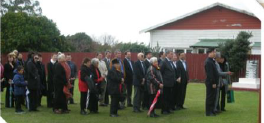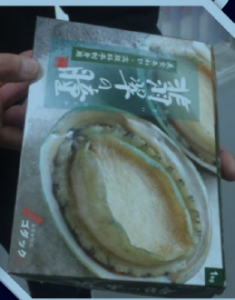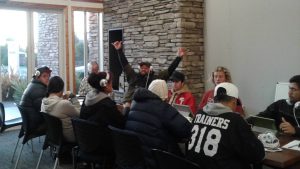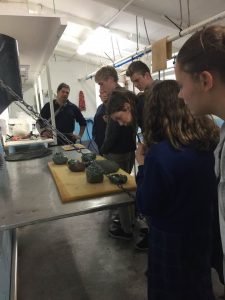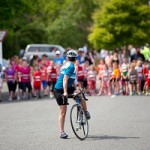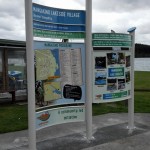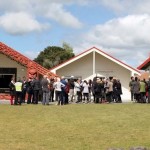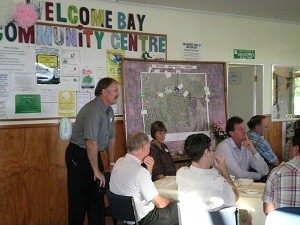Ōpōtiki using their taonga to harbour a dream
Decades ago, some Whakatōhea kaumatua advocated farming the sea, and rebuilding the marine based economy which the Iwi had been renowned for pre-confiscation. At the time there was scepticism – maybe the vision seemed impossible….
Ōpōtiki now has the largest offshore marine farm in New Zealand and local iwi, Te Whakatōhea is the majority shareholder. Over the past 20 years Te Whakatōhea and partners have co invested in research and farming infrastructure to harvest spat and grow mussels. Both are now being produced at extraordinary rates.
It’s now time to fulfil the plans to develop the Ōpōtiki Harbour so that both the farm can be serviced and the mussels processed locally – generating local jobs and wealth. Regional commitment to investment is lined up, awaiting government commitment so that construction can commence.
Ōpōtiki, an eastern Bay of Plenty sea side town resident to nearly 5 thousand, was once considered one of New Zealand’s most deprived communities. The town has had heavy unemployment, decreases in population, and a large dependence on government benefits. Increasingly both locals and outsiders are perceiving it differently. They’re beginning to believe that benefits plus seasonal work in kiwifruit need no longer be the only option for a significant portion of the population.
Through their joint leadership, Te Whakatōhea and the Ōpōtiki District Council have integrated iwi and community-led development approaches to empower their community’s transformation.
Shared local visions drive action and change
Ōpōtiki had a desire for change, they envisioned a community that could be more sustainable: Iwi saw opportunity for economic growth congruent with their values and aspirations, that would lead to job opportunities for their people; the Council saw potential in a sustainable seafood industry, along with other industries enabled by a viable harbour, which would all support the community’s wider vision for change.
Using existing strengths and assets
UTe Whakatōhea has a strong connection to the sea. Traditionally known as enterprising seafarers and coastal traders, their history is closely linked to the ocean. The community saw their vision as an asset, one of great value in rebuilding a vibrant local economy and wellbeing. Layered over this was Ōpōtiki harbour. It had been developed in European settlement times for whaling and coastal trading, and was once a busy, thriving harbour – a connection to both European and Māori heritage.
Many people, groups and sectors working together
MTe Whakatōhea, settled on their vision to develop the marine farm, reached out to multiple groups and organisations to assist. Ōpōtiki District Council, with community support got behind the initiative, taking leadership to develop the Harbour. Getting the marine farm underway and confirming the viability of the harbour development has been complex. Processes with community, iwi, multiple central and local government layers, scientist, researchers, investors and a wide range of businesses. There’s been effort regionally, nationally and internationally over many years and that’s created more relationships and trading opportunities both here and overseas.
The Ōpōtiki Marine Advisory Group, established nearly a decade ago, has been a constant thread at the local level, bringing Council, Te Whakatōhea, marine farm leadership and other business people, to the table, along with funders, the regional council and economic development agency.
Working adaptively, learning informs planning and action
WOver the decades of persistence, patches of progress have been frequently interrupted by knock- backs and road- blocks. Two things stand out. One is a collective determination to keep going, learning from experience and adapting to new circumstances and ideas. The other is the value of diverse skills, knowledge and leadership skills around the tables driving these projects, which means different people and organisations can step up when leadership is needed, and then step back as new challenges and opportunities emerge, demanding other expertise.
Watch Ōpōtiki Mussell Farm on Seven Sharp.
Te Hā o Mātauranga Kaikoura
Te Hā o Mātauranga – Learning in Kaikōura is a community hub. Local people people doing extraordinary things following the 2016 Kaikōura earthquake.
Kaikōura is a small coastal town located on the east coast of the South Island – largely known for its whale watching and tourism economy. Te Hā o Mātauranga – Learning in Kaikōura , opened its doors in March 2017 only 3 months after the 7.8 magnitude earthquake that struck the town the previous November. Operating from what was once Kaikōura ’s museum building, the space has been transformed into a community collective with workshops and educational training.
Talking to Sarah Beardmore the Coordinator of Te Hā o Mātauranga, it’s easy to see the enthusiasm and love the community have for their town.
“Our main ethos is to promote, enable and encourage learning opportunities within the community. With support of the JR McKenzie Trust, MBIE and the Lottery Hurunui Kaikōura Marlborough earthquake relief fund we are building on exciting prospects, while recognising the impact the earthquake has had.”
One example is MBIE’s Curious Mind Fund. “It enabled us to join with University of Canterbury to work with local youth who have become involved in the post earthquake science research that has brought so many scientists to Kaikōura ” Sarah says SKIP has also been involved in funding positive activities for parents of 0 – 5 year olds – one of the activities, a photovoice project designed to share stories about sleep since the earthquake, will culminate in an exhibition in the anniversary week of the earthquake in November.
“But we want to look forward. So we’re running workshops to garner ideas and vision. Megan Courtney and Kindra Douglas from Inspiring Communities’ ran two workshops here recently, helping the community to build on their existing strengths in a sustainable way.”
Community-led principles are also scattered throughout Te Hā o Mātauranga’s approach to recovery and positive change.
Utilising existing strengths and assets
“The issues facing Kaikōura existed pre-earthquake but they are just greater now. The community Is turning a negative situation into something positive. By capitalising on the environment, using our contacts and our community’s strengths we have come together and enabled the community to move forward using tools like education. An afterschool programme for children run by a passionate local, to create crafts from recycled materials has led to new ideas around adults creating items from recycled materials – hopefully for on-selling. Local experts have come forward to support learning – for example a primary school teacher has run reading afternoons for school children and another is running slam poetry workshops. “
Shared local visions drive change
The group and the community as a whole are focusing on upskilling: promoting education across all age groups. “So we encourage external providers to offer training in Kaikōura , but as well, we support locals to share their skills and ideas.” Te Hā’s space has hosted a number of different educational training sessions from a partnership with He Toki, a Ngāi Tahu Māori trades training academy, who ran a 3 week course supporting people getting back into work, to a tertiary level business administration course run by ARA.
Many people, groups and sectors working together
Te Hā o Mātauranga is looking towards the next five years. The goal of the hub is for our Kaikōura families to have the confidence and optimism to make the choices they want to. Sarah reinforced the important role Te Hā is now playing to “connect and enable locals, local and central government agencies, philanthropists, businesses – basically anyone with a role to get us to that goal!
“By growing a culture of learning in Kaikōura and promoting and enabling learning opportunities, we hope to give people the support they need to grow their skills, confidence and capability.”
For more information, see their Facebook page here.
Using ‘It’s not OK’ at Rugby League
By He Tauaa Rugby League Club Acting President Fipe Fa’amoe.
The situation
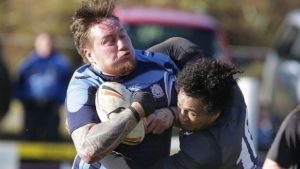 He Tauaa Rugby League club in Southland has been around since 1983. “He Tauaa” to the old Maori people, means, ‘A well drilled and organised war party of men, who would raid other tribes to show their strength and bring back the spoils.’
He Tauaa Rugby League club in Southland has been around since 1983. “He Tauaa” to the old Maori people, means, ‘A well drilled and organised war party of men, who would raid other tribes to show their strength and bring back the spoils.’
We are doing well on the field – most recently and what may be our greatest achievement – is winning the Southland Championship back to back four years running.
Being well drilled and organised, can only come from hard training, connectedness between all members and providing an environment that encourages positive behaviour.
We wanted to address a number of incidents that were taking place during the games. Back chatting to the referees, abusive comments from the side line towards players and bad attitudes. Often not from our team but none the less change was needed.
So when the opportunity to be part of the New Zealand Rugby League (NZRL) “It’s more than a Game” initiative, which promotes healthy living, positive behaviour and building stronger individuals, families and communities – we jumped at the chance.
What’s happening
We became the Southland Champion Club for the ‘It’s Not Ok’ initiative for 2016. An informative day with stall holders and guest speakers providing vital information.
Banners and flags supporting the campaign have flown freely at the games. Two club members volunteered to be our Club Champions, when there was inappropriate side-line behaviour they approached the players and supporters concerned and asked them to calm down and be more positive. The odd negative comment is quickly stamped on. The coaching team play a big role as they continually drive into the players that they need to display a good attitude and positive behaviour. This occurs at training, before and during their games. If there are any issues that require intervention, these are discussed and dealt with by our Committee.
One of our Club Champions Chris Perriam has been involved in rugby league for 29 years – 23 of them with He Tauaa. He says it’s been an honour and a privilege to represent the club as one of the Champions.
“This has been the only campaign that the Southland Rugby League community has been able to get behind that effects nearly all of us.
Growing up, family violence was a common occurrence in our house so to be a club champion was something close to the heart. I put my hand up because I know we all have our struggles in life, but there are people who can help; people who you can talk too if it is easier than talking to those closest to you. This campaign was more about letting the community know we care and to let them know that help is as close as they might think.”
The change we’ve noticed
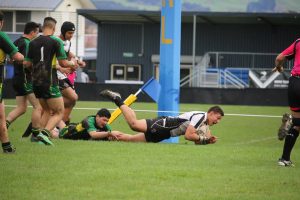 The back chatting from our team on the field this season has notably reduced in our club and side line behaviour has improved. This has been noticed by our supporters and members from other clubs. Support for this initiative has been amazing. Our players, their families, friends, Southern Zone Rugby League, our sponsors and members of the Family Violence team all attended the launch.
The back chatting from our team on the field this season has notably reduced in our club and side line behaviour has improved. This has been noticed by our supporters and members from other clubs. Support for this initiative has been amazing. Our players, their families, friends, Southern Zone Rugby League, our sponsors and members of the Family Violence team all attended the launch.
What enabled change?
One of the club champions Leona Notoa says that small things like flags, posters and tee shirts have been a constant reminder to people. Being part of the campaign meant people felt more confident to yell out and stop anything that was negative or unnecessary – referring to the slogan, “It’s not OK. Although there is still the constant banter between teams and spectators the reminder was looming and it sparked conversations.
What we’ve learned
The strength of our club is that we are whanau orientated and supportive of each other. We understand that each of us have a role to play to ensure that we are successful on and off the field. If we can continue with a positive attitude, this filters to our members and their families.
What’s next
We have certainly got off to a good start as the club won the 2016 NZRL Grassroots club of the year award for our work with the It’s Not OK campaign – we are all stoked!
We have connected with a local musician who has agreed to create a song and music specific to He Tauaa. We are hoping that the song will be ready early next year when we hold our next big event for the it not ok campaign.
Chris has produced a video:
Selwyn Steps up .. and out
By Michael Wilson, Executive Officer, Selwyn Sports Trust
The Situation
In 2011 we often found asking ourselves, why? Why is Selwyn not readily recognised as a District? Why are the vast range of physical activity opportunities in Selwyn not better known? Why are Selwyn residents not catered for with ‘their own’ events? Why, why, why…
Who is involved
The ‘we’ was a group of Selwyn residents and sports enthusiasts. We had a range of experiences, involvements and ideals when it came to sport and physical activity. The thing that bound us was the pos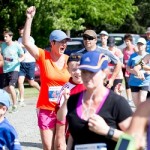 itive place we held sport and physical activity and the positive influence it had on us all. We wanted to share this with the whole Selwyn District. Selwyn Sports Trust was born from this.
itive place we held sport and physical activity and the positive influence it had on us all. We wanted to share this with the whole Selwyn District. Selwyn Sports Trust was born from this.
Well, honestly, Ellesmere Road Runners and the Selwyn Running Festival were born. Both were based out of Leeston and the community took to them. A weekly, community minded running and walking group coupled with an event that was the goal for all that regular exercise.
What we have done and how
Selwyn Sports Trust was established as we figured the support and enthusiasm shown by the Ellesmere community could be replicated Selwyn wide. The aim being to promote and support participation in sport and recreation within our District.
From humble beginnings, we have remained largely events based. Adding to our weekly running and walking groups and we’ve connected with the Malvern and Lincoln communities so we are engaging with more than 450 individuals annually.
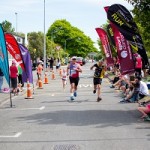 We’ve built strong relationships with other invested groups and organisations to enhance the Shoe Clinic Selwyn Running Festival. We also incorporate the Athletics Canterbury Half Marathon Championship in the Lay Associates Half Marathon, giving locals a chance to see Canterbury’s finest runners and even compete alongside them. And we’ve engaged with local businesses (McMillan Drilling Group, Oakleys Premium Fresh Vegetables and G & M Contracting) who provide more than just financial support – guidance and involvement within the Festival too.
We’ve built strong relationships with other invested groups and organisations to enhance the Shoe Clinic Selwyn Running Festival. We also incorporate the Athletics Canterbury Half Marathon Championship in the Lay Associates Half Marathon, giving locals a chance to see Canterbury’s finest runners and even compete alongside them. And we’ve engaged with local businesses (McMillan Drilling Group, Oakleys Premium Fresh Vegetables and G & M Contracting) who provide more than just financial support – guidance and involvement within the Festival too.
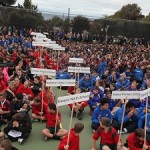 We have added two other annual events to fill gaps we identified. The Frontrunner Lake Crichton Series was a no brainer addition. Not only does this showcase the fantastic, yet largely unknown, facility – Lake Crichton, it provides first time triathletes with one of the safest ways to give the sport a go.
We have added two other annual events to fill gaps we identified. The Frontrunner Lake Crichton Series was a no brainer addition. Not only does this showcase the fantastic, yet largely unknown, facility – Lake Crichton, it provides first time triathletes with one of the safest ways to give the sport a go.
The Koru Games give South Island year 7 & 8 students an opportunity to develop their individual sporting skills while playing teams sports for their schools. There were 2000 competitors in 2016. With the support of Sport Canterbury, we will be unleashing our Physical Activity Activators on 23 Selwyn Schools from 2017.
The change we have noticed
More active communities being active together. A wider range of friendships, interactions while exercising, racing and socialising. The invisible silos within our communities have been broken down to a certain extent through people being active together, be these generational, social, gender and so on.
We hear from many of our participants that their perception of what racing is and who it is for has changed from being something for the elite and very capable and 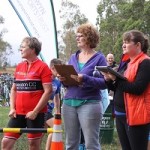 committed to something for all. We also hear that highlighting and utilising local resources and facilities is a fantastic way to show off and bring pride to the District and its residents. It’s also a great way to open the eyes of locals to what they have on their own doorstep.
committed to something for all. We also hear that highlighting and utilising local resources and facilities is a fantastic way to show off and bring pride to the District and its residents. It’s also a great way to open the eyes of locals to what they have on their own doorstep.
What we’ve learned
It has required a huge commitment from a large number of selfless individuals and organisations to begin the journey. We are very conscious of all the support and guidance we have received so far, from the individuals standing on corners during races, to those that fill out reviews to ensure we continue to cater to their needs, to the financial contributors.
We believe the initiatives and events that are the most successful are those that directly engage with their competitors and participants. Those that have clear and understood goals, vision and direction that is malleable are most successful.
We also believe that the word success has to be clearly understood. We are most definitely clear that success is not having the most participants, the largest events or making large amounts of money. It is our goal to enrich people’s lives and community well being through sport and recreation and this is how we measure success.
More info: selwynsportstrust.org.nz/
Mangakino & Whakamaru Heritage Trail
The Mangakino and Whakamaru Heritage trail has been blessed and opened (Nov 2016). When Mangakino people talked about their visions for the future during “Wow! E tū Mangakino! Let’s Dream” back in 2011, one of their community aspirations was to celebrate their area’s heritage more.
This trail is designed to link with the Waikato River Trails which attracts thousands of visitors PAST Mangakino annually – now the Heritage Trail offers them a side tour through the Townships and many memorable moments!
It’s taken a huge amount of research, persistence and patience from many people and especially Lisa, the local community broker. Recently the Mangakino community-led development group organised a community celebration for 70 years since the township was established, and blessed the new Heritage Trail – they invited everyone who had helped, along with residents of today and yesteryear. On a beautiful day at Pouakani Marae, locals, past residents and supporters gathered to enjoy and share memories, and to celebrate Mangakino.
Think local and let local do
By South Waikato Mayor, Neil Sinclair
 A truly multi-cultural District the South Waikato is right in the centre of the North Island between Hamilton Rotorua and Taupo. We are home to 23,000 people, of which about 30% are Maori and 11% Pacific Island. We are a young district, our main town, Tokoroa, was established in the 1950s when the paper mill at Kinlieth was built. Now we are 50% farming 50% forestry.
A truly multi-cultural District the South Waikato is right in the centre of the North Island between Hamilton Rotorua and Taupo. We are home to 23,000 people, of which about 30% are Maori and 11% Pacific Island. We are a young district, our main town, Tokoroa, was established in the 1950s when the paper mill at Kinlieth was built. Now we are 50% farming 50% forestry.
Yes we had a tough image, an image that unfortunately lives today. We are however a proud caring compassionate community. I know, I was a dentist for 40 years. We have the lowest crime statistics for the Bay of Plenty and my towns are almost devoid of any graffiti. But like all rural New Zealand towns we are looking at a decline in population and an aging population. We have, additionally, high youth unemployment, some poor housing stock and we are generally regarded as being a low socio economic district. It’s not an exciting picture, so why are we so confident about our district and our towns?
Councils and communities in general have to recognise their situation, accept who they are and then they can work out just what they have to do to create change. Identify your local strengths.
For us it is that we have a particularly caring, resilient community. In 2004, when I first became Mayor, through a series of circumstances I, with many others, stood on an empty section of Council land on a Thursday evening. By Sunday lunch time I was opening a children’s park on that land, with a sound shell, flying fox, BBQ, unique play equipment, swings, and a graffiti board. All done by the community. All manner of people were involved in the construction; clubs, groups, individuals, businesses, groups of people who fed us. $20,000 was raised, not a dollar from Council. Looking back now not even a resource consent! All done in 48 hours.
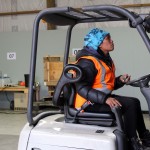 So if the community were going to be the doers then it would require an innovative, imaginative, courageous council to work with them and harness that spirit. High youth unemployment was one of the big concerns then. Council knew education was the way forward so we instituted the Mayoral Scholarship. We have great schools producing very talented individuals. Our town, because of the mill has many high-quality engineering firms; many exporting,all calling for trained staff. Council looked at the Otorohanga jobs project and decided not to copy but upgrade it. Council put $90,000 into the development of a Trade Training Centre and instructed that the best of lathes be bought. If we believed in our youth, then they needed the best equipment. Give them second hand gear and that will be how they think we feel about them.
So if the community were going to be the doers then it would require an innovative, imaginative, courageous council to work with them and harness that spirit. High youth unemployment was one of the big concerns then. Council knew education was the way forward so we instituted the Mayoral Scholarship. We have great schools producing very talented individuals. Our town, because of the mill has many high-quality engineering firms; many exporting,all calling for trained staff. Council looked at the Otorohanga jobs project and decided not to copy but upgrade it. Council put $90,000 into the development of a Trade Training Centre and instructed that the best of lathes be bought. If we believed in our youth, then they needed the best equipment. Give them second hand gear and that will be how they think we feel about them.
A group of the leaders from those engineering firms came together and set the syllabus around what they wanted as employers.The Waiariki Polytec then came on board as the Industry Training Organisation – with our lathes and industry-set syllabus. It has set the bench mark for Trade Training schemes.
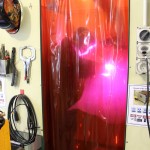 We now have engineering, auto engineering, welding, horticulture and farming training. The job uptake by our students is 97%. They know if they stay home and don’t attend someone is ready to take their place.
We now have engineering, auto engineering, welding, horticulture and farming training. The job uptake by our students is 97%. They know if they stay home and don’t attend someone is ready to take their place.
I have many more examples: Local Communities like mine have that community determination; Councils like mine have the ability to create partnerships with industry, such as what we did with Fonterra’s new $385 million milk drier, the Blue Pacific Minerals expansion, John Deere opening an engineering factory. There is the 50,000 hectares of forestry conversions that have been done using best farming practices and have brought more than 90 new families into the District.
So we can do, but how do we get Central Government to recognise that sub regional growth is taking place? Small communities like mine are making things happen because we have to if we are to maintain that which we treasure. I have had only one Cabinet Minster visit – he was in and out for the opening of the rail hub. Regional Growth they say is exploding but they mean Hamilton. We need recognition of sub-regional needs.
Encourage Local Councils like mine to be brave, courageous with their innovation and imagination. Encourage us, don’t wait and then say congratulations. As always finance is the biggie. Most of what we have done took more time than it should have as we had to justify every penny. We aren’t rich – far from it – so caution was the message, and frankly sometimes courage. We can do. Rural New Zealand can do, we all need to think local and let local do.
Building Business Connections over Breakfast
By Anna Larsen, Manager, Welcome Bay Community Centre Inc
The Community Centre in Welcome Bay is in the heart of a unique Tauranga suburb. Welcome Bay’s nearly 18 thousand people make up 1/6th of Tauranga’s population, yet it has very little social infrastructure and virtually no employment opportunities. The suburb acts as a dormitory, with most people in paid employment, and all school students over 11 commuting out of the suburb daily. Teaching is the main occupation in Welcome Bay – we have four primary schools, two state kindergartens and a number of Early Childhood Education centres. There is no public library, very few recreational facilities, and no supermarket. There is very little within the community that traps money in a local economy.
But there IS a strong core of home-based self-employed businesses, and without casting our net very wide, we discovered that when it comes to practical skills, you don’t need to go far to cover most of the trades. Our community should be able to meet most of our business needs without going outside of the local business sector. The missing link is that we don’t know each other, yet one of the greatest users of business is business!
The Welcome Bay Community Centre has been actively engaging with business people over the past couple of years through the establishment of a Business Network. It’s been a slow process, but the local business community has been keen to engage with the wider community.
We held a Business Network Breakfast in January 2014. The Tauranga City Council’s Chief Executive, who was new to the city as well as his job then, was our guest speaker. His presentation in front of a packed room generated some wonderful conversation focussed on the local community, and gave him some grunty food for thought to chew on. Subsequent breakfasts featuring the Tauranga Chamber of Commerce’s Chief Executive and our local MP have also been a great success. We also encourage breakfast network participants to bring their business opportunities to the wider local community.
Our next step is to invite them to support a local quarterly publication that will appeal to the community with relevant editorial content, interesting articles, informative columns and a directory of the local businesses. We’re keen to make sure our local business people are connected to each other and to our local people. It’s part of generating a sense of belonging and engagement in our great place.
More info:
email: centremanager@welcomebayorg.nz
Visit: www.welcomebay.org.nz
https://www.facebook.com/WelcomeBayCommunityCentre?ref=hl
Eketahuna – It’s a long way from the city
By Bridget Wellwood , Chair of both the Eketahuna Our Town Committee and the Eketahuna / Mellemskov Museum
How does a small town, famous for being in the middle of nowhere in particular (Eketa-where?) hope to survive in today’s economic climate?
We are up against it – unemployment, low socio-economic stats, unstable dairy prices, a reputation for rainfall, for starters.
With only 450 people living in town and over half of those people earning less than $20,000 pa, the challenge of economic development seems unobtainable.
Yet Eketahuna residents are working together to find local solutions, to push the boundaries, and to draw people closer.
We are a resilient community and out of adversity Eketahuna has always bounced back. After the petrol station burned down, we responded by floating debentures (seeking the support of the local farming district as well) to rebuild a new station, now leased by local operators but still owned by the community (Eketahuna Charitable Trust). People said it couldn’t be done – but the business is flourishing.
Similarly the local grocery store faced closure – debentures were offered and it is now a thriving Four Square leased, but jointly owned, by the Eketahuna Charitable Trust and Masterton’s Trust House. It is the hub for the community.
There are too many community organisations to list, people here want to make a difference. If something doesn’t exist we roll up our sleeves. For example the local Youth Trust want a Skate Park – these kids are out fundraising, and are being well supported by the community (and funders) for their initiative.
We have a library, a good health centre, primary school, swimming pool, op-shop, police, ambulance and fire services amongst our locally run services.
Eketahuna has always been a stop off point. Today people stop for the (newly upgraded) loos and petrol, as well as for the fabulous coffee shops and boutique design and interiors shops that are now open, or to explore some of the lesser known attractions – the Cliff Walk, the local art gallery, or a round of golf.
The Eketahuna Our Town Committee wants to capitalise on possibl e tourism benefits so we are undertaking a number of projects, such as mapping routes to take advantage of the growth in recreational biking, The Eketahuna / Mellemskov Museum is re-inventing itself, becoming more interactive with the community and hosting pop-up exhibitions.
e tourism benefits so we are undertaking a number of projects, such as mapping routes to take advantage of the growth in recreational biking, The Eketahuna / Mellemskov Museum is re-inventing itself, becoming more interactive with the community and hosting pop-up exhibitions.
And the newly developed Eketahuna Railway Station – a collaborative community project to reinstate a small station – is a huge success bringing people here on steam train day excursions.
We have also become event focused running a variety of historical, medieval and art expos over a number of weekends throughout the year.
Self-employment is a good option here and people are thinking hard about social enterprise and collaborations as an effective means to reduce overheads – working together in shared workspaces makes good sense.
We are rebranding the Eketahuna experience getting beyond people’s perceptions that we might be a backward place to some new quality tourism products. Small we may be but that certainly doesn’t equate to our vision of how things might be in our future.
How a plan comes together
 By Janine Boult, Kaiwaka Cares
By Janine Boult, Kaiwaka Cares
In a small community timing is everything. The same ideas may float to the surface again and again. What makes the difference is having a person, or people, to take the ideas and keep them alive and from them create a reality. That’s what’s happening in the small township of Kaiwaka in the gateway to Northland.
A group of like minded citizens were brought together in late 2014 as part of an initiative to improve what Kaiwaka has to offer and how it works with its community. Some members felt called to take up the challenge. This is how our group, Kaiwaka Cares, was born.
Since then the community service has grown to include re-development and upkeep of the community garden as well as the establishment of a drop-in centre – open three days a week. Whilst the garden feeds the body, the drop-in centre feeds the soul and the feeling of community within Kaiwaka.
Our committee has learnt as number of lessons over the past six months, and I am sure there will be more. Any time a new person enters a community they bring their own life’s experiences and knowledge. Often they are enthusiastic and want to change the world overnight and fill the gaps that a newcomer sees. It is hard to hold back and allow change to happen more organically.
In a community as old as Kaiwaka no idea is new, it has been thought of and attempted previously. The trick is to learn from the past, and to preserve and gain support from leaders in the community and the respected elders. In particular our idea of having a drop-in social space was unpopular with some. Many times we heard; it wouldn’t work, it was a waste of time, and how everyone already knows everyone.
We turned this around with a bit of thick skin, determination, stubbornness and resilience. By sitting down and sharing a cuppa with some of these people we have not only gained their knowledge and advice, we know they have our backs and we have their support. Yes there are still detractors, some more vocal than others but over time I hope that will change.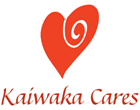
The biggest gift you can do for yourself when volunteering or creating something new for your community is to pace yourself. Take care of yourself first. Don’t try and do everything the first day, give it time. Take small steps and allow each step to fulfil its potential before expanding or trying to jump onto the next level.
I have a quote on the wall by my computer from Mother Teresa: “I can do things you cannot, you can do things I cannot; together we can do great things.” Putting this into our community is one of my goals. As a community if you leverage the skills and experience of all then you will have a community that your grandchildren will be proud of.
Read more about us caring4kaiwaka.blogspot.com
A Business Approach to Change
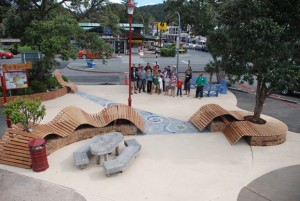 By Denise Bijoux and Grant Harnish, Focus Pahia Co-founder
By Denise Bijoux and Grant Harnish, Focus Pahia Co-founder
Real change is going on in Paihia which is visible in the local landscape as well as in the accolades and awards they’re winning – including 2015 Community of the Year!
But visible change is not all.Local people and local systems are changing too.
Fundamental to this is the business approach Focus Paihia takes to the action-focused model developed and mandated by local people.
The visible change is perhaps most apparent on the waterfront, where once there were parked cars and now there is seating, a sculpture, a little library and games. It’s is also obvious at the Maiki Hill public toilets.
As Tania McInnes Focus Paihia Co-founder and now Far North District Council Deputy Mayor says,“simply put – Paihia stopped waiting for someone else to fix their problems. It took responsibility and put words into action. It’s all about having a common goal, building community spirit and getting your hands dirty.”
In 2009, Focus Paihia worked with local people to develop a collective vision for Paihia village which led to a mandated masterplan within a year.
Placemaking provided a vehicle for making things happen, and while they are a community based trust, the funding side is run with a strong business ethos to ensure ongoing supply of funds.
Their first project involved renovating an unattractive public space next to the local i-Site. It was transformed by more than 100 volunteers over one weekend using just $5,000 provided by the local community board.
Since then, many other projects have been completed, including the waterfront park where the $180,000 spend and 9,000 volunteer hours has created a space valued at $1.3 million.
Focus Paihia provided 90% of the funding for the park through their sustainable funding sources:
- a committed pool of volunteers donating time and resources
- volunteer-run Op Shop profit
- contracts, including cleaning up after the Rena and cleaning and maintaining the village green
- Grants from a targeted rate

Maiki Hill toilets.It’s hard to believe this is the same building!
Operating Focus Paihia like a business makes more sense, according to another co-founder, Grant Harnish. It means “that we are in charge of what we do. We can change things as we go, it’s more creative, fun and better use of our time.
“The answer lies in having a mandated masterplan and in local people actively carrying out the plan’s actions. If it is done with heart, it will be comfortable,the people involved will be proud and they get to know each other better.”
The Trust takes a no surprises approach and has developed a strong respected relationship with key agencies, including Far North District Council and New Zealand Transport Authority. It also helps that people involved remain open to change.
Focus Pahia has been so successful that they are developing a toolkit to share what has worked for them. The hope being that it will encourage more people to take responsibility and develop a bond and community spirit from the ground up and thus be in a much stronger, more resilient position to face whatever the future holds.
More info: http://focuspaihia.org.nz

